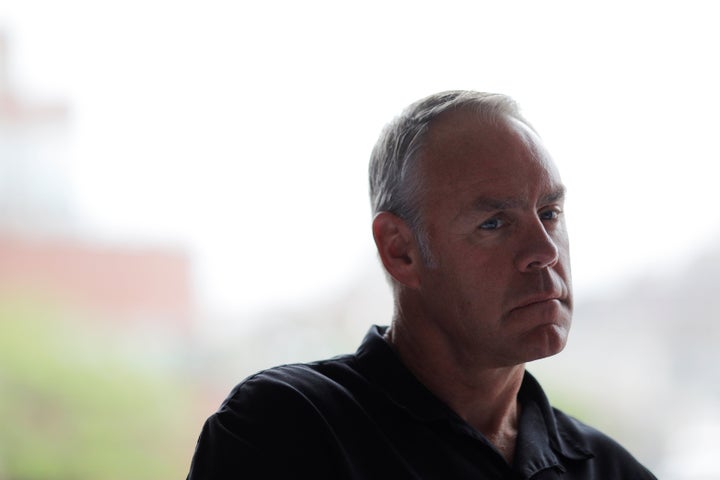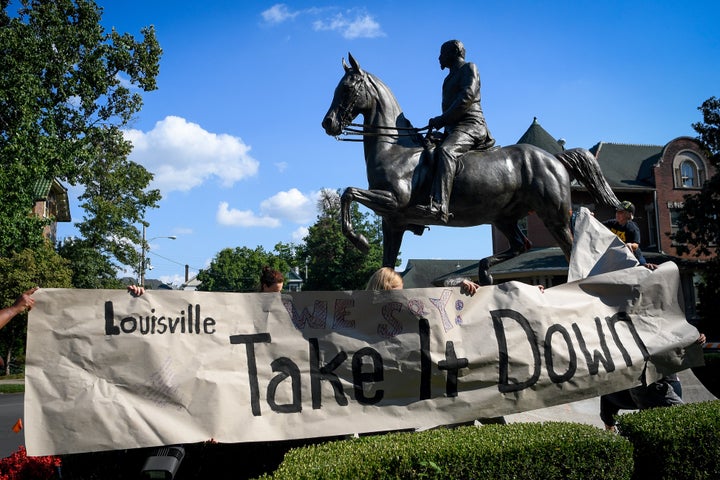
WASHINGTON ― Interior Secretary Ryan Zinke says that if Confederate monuments are taken down, there’s no telling how far America might go —Native Americans could call for the removal of statues commemorating leaders who orchestrated violence against their ancestors.
“Where do you start and where do you stop?” Zinke asked in an interview with Breitbart published Sunday. “It’s a slippery slope. If you’re a native Indian, I can tell you, you’re not very happy about the history of General Sherman or perhaps President Grant.”
William Sherman was a Union general during the Civil War who later used the military to force American Indian tribes to move to reservations. He wrote in 1868 that, “the more I see of these Indians the more convinced I am that they all have to be killed or be maintained as a species of paupers.”
Former President Ulysses Grant covertly provoked an illegal war with Plains Indians, as Smithsonian Magazine reported, and also presided over the mass slaughter of the buffalo, a culturally significant animal that was also a major resource for many tribes.
Zinke, who oversees the country’s national park system as head of the Interior Department, told Breitbart that the Trump administration will not remove any monuments from federal land, including Confederate monuments. “When you try to erase history, what happens is you also erase how it happened and why it happened and the ability to learn from it,” Zinke said.
But Zinke’s remarks seem to ignore the fact that Native Americans have already been calling for the removal of monuments that commemorate white supremacy and historical figures who committed violence against indigenous people.

Many Confederate monuments were erected long after the Civil War had ended, not to honor those who fought, but to promote a “white supremacist future,” as University of Chicago history professor Jane Dailey told NPR. “The proper place for this history is in a museum,” Heidi Beirich, director of the Southern Poverty Law Center’s Intelligence Project, told HuffPost.
In Zinke’s home state of Montana, Native American lawmakers have called for the removal of a memorial to Confederate soldiers that they say stands for “segregation, secession, and slavery.”
Last month, representatives of several tribes also gathered in Gardiner, Montana — the northern entrance to Yellowstone National Park — to petition the government to change the names of two park features named after historical figures: Lt. Gustavus Cheyney Doane, who helped lead a massacre of more than 150 Native Americans in 1870, and Ferdinand Hayden, who once wrote that “unless [Native Americans] are localized and made to enter upon agricultural and pastoral pursuits they must ultimately be exterminated.”
In blasting the removal of Confederate statues, Zinke is echoing President Donald Trump, who remarked in August, “You really do have to ask yourself, where does it stop?”
Critics say Zinke’s latest statement about American Indians is dismissive and misses the point of efforts to remove Confederate statues in the first place.
“He seeks to sidestep the initial issue and casually mentions American Indian complaints as a reason why the Confederate statues should stay,” Candessa Tehee, former executive director of the Cherokee Heritage Center in Oklahoma, told HuffPost. “His comparison is like saying one wrong move justifies another.”
Zinke is “acting as an apologist for Confederate monuments that make no effort to present a balanced and informed view of history,” said David Hayes, the Interior Department’s deputy secretary under President Barack Obama.
“The National Park Service rightly prides itself in providing an accurate and balanced view of America’s historical sites,” Hayes added, pointing to the Selma to Montgomery National Historic Trail in Alabama and the Little Bighorn Battlefield National Monument in Montana.
“The National Park Service doesn’t always get it right. But for many years, it has recognized its special obligation to responsibly present our nation’s history,” Hayes said. “Abdication of this responsibility with simplistic rhetoric ... is, at best, unbecoming to the Interior Department and the National Park Service.”
Zinke is obligated to appreciate, preserve and explain American history, Hayes added.
The Interior Department did not respond to HuffPost’s requests for comment.
“His comparison is like saying one wrong move justifies another.”
- Candessa Tehee, former executive director of the Cherokee Heritage Center
Zinke’s relationship with Indian Country has been rocky. In 2014, when he was running for a Montana House seat, he drew fire for saying the problem of unemployment on local reservations stemmed from a “dependence on the government.” Tribal representatives accused Zinke of promoting stereotypes about Native Americans and of lacking empathy and historical awareness.
When Zinke was sworn in as Interior Department head in March, he vowed to champion indigenous communities. He said “sovereignty should mean something” and that “Indian nations and territories must have the respect and freedom they deserve.” Some Native Americans say they are hopeful about his policies, even as he has pushed a proposal that would slash the Bureau of Indian Affairs budget more than 10 percent and cut $64.4 million from Indian Affairs education programs.
In August, Zinke revised the agency’s Land Buy-Back Program for Tribal Nations, which aims to address the widespread problem in Indian Country of land fractionation, a threat to tribal sovereignty. The sudden change meant dozens of tribes were cut out of the program entirely. A former Interior official told HuffPost at the time that there was no consultation with tribal leaders about the new strategy.
Zinke has suggested that Trump consider establishing a new national monument in Montana’s 130,000-acre Badger-Two Medicine area, a site the Blackfeet Nation considers sacred. But he has also recommended shrinking or otherwise weakening at least 10 existing monuments that safeguard natural resources, according to a leaked copy of the report Zinke submitted to the White House in late August.
Among the monuments Zinke sent to Trump’s chopping block is Bears Ears National Monument, 1.35 million acres of protected public land in southeastern Utah that is home to thousands of Native American archaeological and cultural sites. The Bears Ears Inter-Tribal Coalition, a group of five tribes, condemned Zinke’s recommendation as a “slap in the face.”
It says a lot about Zinke that “he’s willing to go to bat for monuments to Confederate generals”— but not those that protect sacred Native American sites, said Matt Lee-Ashley, a senior fellow at the liberal Center for American Progress.